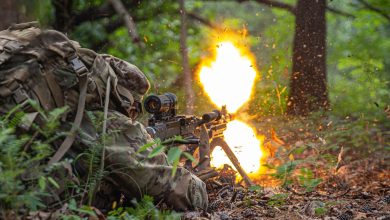Air Force starts ground testing Anduril collaborative combat aircraft

The Air Force has started ground testing its first Anduril-made semiautonomous drone wingmen known as collaborative combat aircraft, which could be flying within months.
Air Force Chief of Staff Gen. Dave Allvin announced the beginning of the ground testing phase in a post on X, formerly known as Twitter, Thursday morning. It included a video of hangar doors opening dramatically to reveal Anduril Industries’ YFQ-44A, which the company previously referred to as Fury.
“This is a huge milestone and another step toward first flight and rapid delivery [of CCAs] to our warfighters,” Allvin said. “These unmanned fighters are going to be badass!”
Now that ground testing of Anduril’s CCA has begun, the company said in a statement, it expects to start flying the YFQ-44A this summer.
“Together, Anduril and the United States Air Force are pioneering a new generation of semi-autonomous fighter aircraft that will fundamentally transform air combat,” said Jason Levin, Anduril’s senior vice president of air dominance and strike. “YFQ-44A delivers highly capable, mass-producible, and more affordable fighter capability at the speed and scale required to stay ahead of the threat.”
The Air Force also said it wants to locate the first aircraft readiness unit for CCAs at Beale Air Force Base in California. That unit will be in charge of “provid[ing] combat aircraft ready to deploy worldwide at a moment’s notice,” the service said in a statement.
The Air Force in April 2024 announced it had selected Anduril and General Atomics to design, build and test the first iteration of CCAs, which will fly alongside aircraft such as the F-35 and the Next Generation Air Dominance fighter now known as the F-47.
CCAs will use autonomous software to fly themselves with minimal direction from the pilots they accompany, and will be able to carry out missions such as airstrikes, intelligence gathering and reconnaissance, electronic warfare, or serving as decoys to lure enemies away from crewed aircraft.
The Air Force has suggested it could have a fleet of about 1,000 CCAs, and said they will be cheaper than traditional fighters. The service wants them to extend the service’s reach at a time when pilots and advanced fighters are in short supply.
Allvin also said on social media that the Air Force’s CCA strategy heralds “a new way of acquisition,” that focuses on quickly iterating new designs instead of sustaining existing models for decades.
“Our new mantra needs to be ‘built to adapt’ rather than ‘built to last,’” Allvin said in the post.
Those comments underscore remarks Allvin made in June 2024, in which he said the Air Force wanted to keep CCA missions simple and costs down, so they can be fielded in large numbers and replaced after a decade or so with fresh models. Allvin also suggested CCAs could be modular and heavily adapted with new technologies to keep them relevant.
Ground testing of General Atomics’ YFQ-42A has not yet begun. In a statement, the company said, “We remain on schedule to test and fly YFQ-42 in the coming months.”
Allvin said in the Air Force’s statement that the beginning of ground tests for the Anduril CCA “bridges the gap between design and flight” and reduces the risk that comes from integrating a new system. He also said both Anduril and General Atomics are meeting or exceeding key milestones, and innovative design and acquisition strategies are speeding up the process for fielding CCAs.
“We’re moving fast because the warfighter needs this capability,” Allvin said. “CCA is about delivering decisive advantage in highly contested environments. … These aircraft will help us turn readiness into operational dominance.”
An advantage of pilotless CCAs is that they will not have to be flown daily to maintain pilots’ readiness, the Air Force said.
That means the readiness unit planned for Beale would be able to keep CCAs in a “fly-ready status” and flown minimally, the service said, which will require a “substantially lower” number of support airmen such as maintainers than other aircraft require.
The Air Force plans to make a decision in fiscal 2026 on which of the two CCA versions to move into production. Also that year, the service expects to start developing the second so-called “increment” of CCAs, which it hopes will have a broader suite of missions it can be used for and integrate cutting-edge technology.
Stephen Losey is the air warfare reporter for Defense News. He previously covered leadership and personnel issues at Air Force Times, and the Pentagon, special operations and air warfare at Military.com. He has traveled to the Middle East to cover U.S. Air Force operations.







